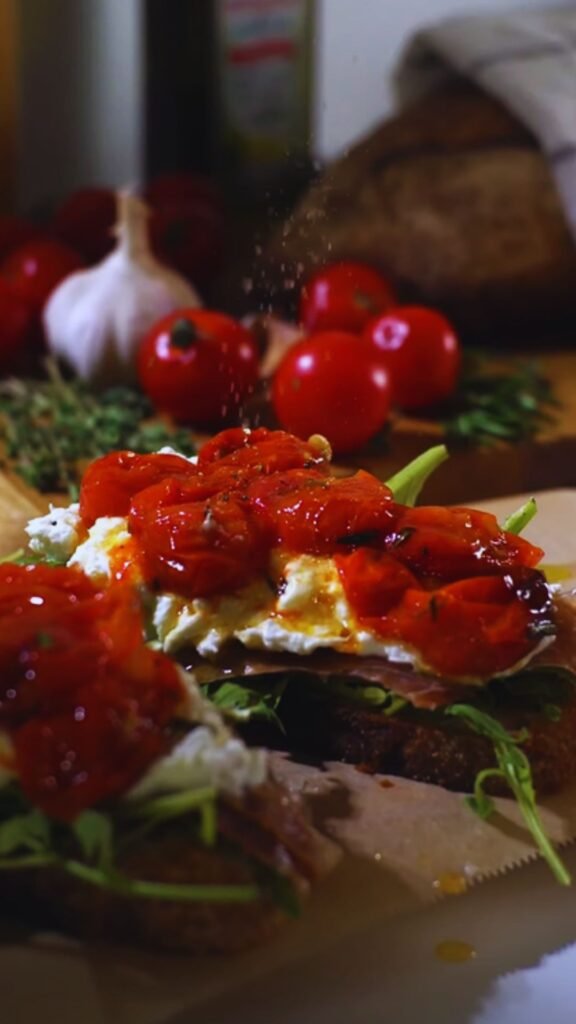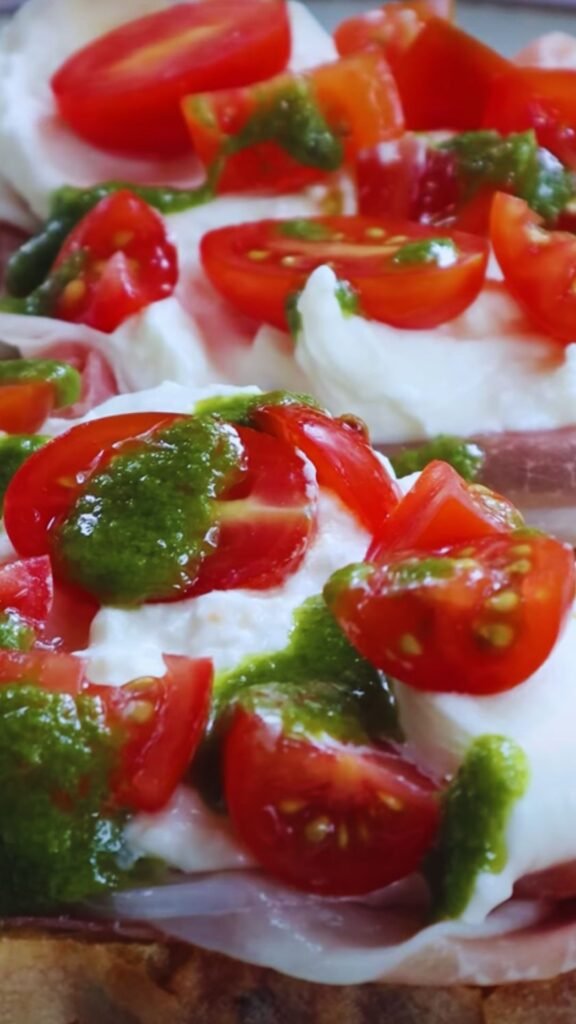There’s something magical about the combination of crusty bread, creamy mozzarella, and perfectly seared tomatoes that makes bruschetta one of my all-time favorite appetizers. Today, I’m sharing my elevated version that features roasted garlic for an extra depth of flavor that will transport you straight to a sun-drenched Italian terrace.
I’ve spent years perfecting this recipe, tweaking ingredients and methods until reaching what I believe is the absolute perfect bruschetta. The secret lies in searing the tomatoes rather than using them raw, which caramelizes their natural sugars and intensifies their flavor profile. Combined with buttery roasted garlic and creamy mozzarella, this bruschetta transforms a simple appetizer into a memorable culinary experience.
What Makes This Bruschetta Special
Traditional bruschetta typically features raw tomatoes, but I’ve found that quickly searing them concentrates their sweetness while maintaining their fresh texture. The addition of roasted garlic brings a mellow, nutty flavor that complements rather than overwhelms the other ingredients. And of course, using high-quality mozzarella adds that creamy, milky component that balances the acidity of the tomatoes perfectly.
This bruschetta works wonderfully as an appetizer for dinner parties, but I often make it as a light lunch paired with a simple green salad. The combination of textures and flavors is absolutely irresistible, and I promise your guests will be asking for the recipe before they leave.
Ingredients
For the Roasted Garlic:
- 2 whole garlic bulbs
- 2 tablespoons extra virgin olive oil
- ¼ teaspoon sea salt
- Pinch of black pepper
For the Seared Tomatoes:
- 1½ pounds (about 6-8) ripe Roma tomatoes
- 3 tablespoons extra virgin olive oil
- 1 teaspoon sea salt
- ½ teaspoon freshly ground black pepper
- 1 tablespoon balsamic vinegar (aged if possible)
For the Bruschetta Base:
- 1 large crusty baguette or ciabatta loaf
- ¼ cup extra virgin olive oil
- 2 teaspoons flaky sea salt
For Assembly:
- 12 ounces fresh mozzarella, preferably buffalo mozzarella
- ¼ cup fresh basil leaves
- 2 tablespoons extra virgin olive oil (high quality for finishing)
- 1 tablespoon aged balsamic vinegar or balsamic glaze
- Flaky sea salt and freshly cracked black pepper to taste
- Optional: red pepper flakes for heat
Equipment Needed
- Oven
- Aluminum foil
- Large cast-iron skillet or heavy-bottomed pan
- Sharp knife and cutting board
- Mixing bowls of various sizes
- Wooden spoon or spatula
- Baking sheet
- Garlic press (optional)
- Serving platter
Step-by-Step Instructions
Roasting the Garlic
- Preheat your oven to 400°F (200°C).
- Slice off the top quarter of each garlic bulb to expose the cloves inside.
- Place the garlic bulbs on a sheet of aluminum foil, cut side up.
- Drizzle 1 tablespoon of olive oil over each bulb, allowing it to seep in between the cloves.
- Sprinkle with sea salt and black pepper.
- Wrap the foil tightly around the garlic bulbs, creating a sealed packet.
- Roast in the preheated oven for 40-45 minutes, until the cloves are golden brown and completely soft.
- Remove from the oven and let cool slightly before handling.

Preparing the Bread
- While the garlic is roasting, slice your baguette or ciabatta on a diagonal into ½-inch thick slices.
- Arrange the slices on a baking sheet.
- Brush both sides lightly with olive oil.
- When the garlic is done, increase the oven temperature to 425°F (220°C).
- Toast the bread slices for about 5-7 minutes, turning halfway through, until they’re golden brown on both sides but still slightly soft in the center.
- Remove from the oven and lightly rub one side of each toast with a cut garlic clove for extra flavor (optional).
- Sprinkle with a small amount of flaky sea salt while still warm.
Searing the Tomatoes
- Core the tomatoes and cut them in half crosswise (through the equator rather than from stem to bottom).
- Gently squeeze each half to remove excess seeds and juice.
- Dice the tomatoes into ½-inch cubes.
- Heat 3 tablespoons of olive oil in a large cast-iron skillet or heavy-bottomed pan over medium-high heat until shimmering.
- Add the diced tomatoes in a single layer (work in batches if necessary to avoid overcrowding).
- Allow the tomatoes to sear without stirring for about 1-2 minutes until they begin to caramelize on one side.
- Give them a quick stir and continue cooking for another 1-2 minutes. The goal is to sear the outside while maintaining some texture, not to cook them to mush.
- Remove from heat and transfer to a mixing bowl.
- Add the balsamic vinegar, sea salt, and black pepper to the warm tomatoes and gently toss to combine.
- Allow the mixture to cool to room temperature, during which time the flavors will meld beautifully.
Assembly
- Squeeze the roasted garlic cloves out of their skins into a small bowl and mash with a fork until smooth.
- Spread a generous layer of the roasted garlic paste onto each toast slice.
- Slice the fresh mozzarella into ¼-inch thick pieces and place on top of the garlic.
- Spoon the seared tomato mixture over the mozzarella.
- Tear fresh basil leaves and sprinkle over the top.
- Finish with a light drizzle of your highest quality olive oil and a few drops of aged balsamic vinegar or balsamic glaze.
- Add a final touch of flaky sea salt and freshly cracked black pepper.
- If desired, add a pinch of red pepper flakes for heat.

Nutritional Information
| Nutrient | Amount per Serving (2 pieces) |
|---|---|
| Calories | 310 |
| Total Fat | 21g |
| Saturated Fat | 7g |
| Cholesterol | 30mg |
| Sodium | 650mg |
| Total Carbohydrates | 22g |
| Dietary Fiber | 2g |
| Sugars | 3g |
| Protein | 12g |
| Vitamin A | 15% DV |
| Vitamin C | 20% DV |
| Calcium | 25% DV |
| Iron | 8% DV |
Note: Nutritional values are approximate and may vary based on specific ingredients used.
Pro Tips for Perfect Bruschetta
Selecting the Best Ingredients
The quality of your ingredients will make or break this recipe. Here’s what I look for:
Tomatoes: Roma (plum) tomatoes work best as they have a higher flesh-to-seed ratio, but any ripe, in-season tomatoes will work. In the winter months, cherry tomatoes often have better flavor than larger varieties.
Mozzarella: Fresh buffalo mozzarella is ideal for its creamy texture and subtle flavor. If unavailable, cow’s milk fresh mozzarella is an excellent alternative. Avoid pre-shredded or low-moisture varieties.
Bread: A good-quality artisanal bread with a firm crust and open crumb structure is essential. I prefer ciabatta or a rustic baguette. Day-old bread actually works better than super fresh as it toasts more evenly.
Olive Oil: Use your best extra virgin olive oil, especially for the final drizzle. This is where you can really taste the difference between standard and premium oils.
Basil: Fresh basil leaves only—dried simply won’t do here. For the best flavor, tear the leaves rather than chopping them, which can cause bruising and darkening.
Technique Tips
- Toast the bread properly: The bread should be golden and crisp around the edges but still have some give in the center. This provides the perfect textural contrast to the toppings.
- Don’t over-sear the tomatoes: The goal is to intensify their flavor while maintaining some freshness and texture. They should not be cooked to the point of becoming sauce.
- Assemble just before serving: For the best texture, assemble your bruschetta no more than 15 minutes before serving. This prevents the bread from becoming soggy.
- Temperature matters: The bread should be warm (not hot) and the seared tomato mixture should be at room temperature for the best flavor experience. Cold ingredients straight from the refrigerator will mute the flavors.
- Season in layers: Add salt and pepper at each stage rather than just at the end. This builds depth of flavor throughout the dish.
Variations to Try
Seasonal Adaptations
- Summer: Add diced peaches to the tomato mixture for a sweet contrast.
- Fall: Include diced roasted butternut squash and sage leaves.
- Winter: Try a version with roasted red peppers and a sprinkle of rosemary.
- Spring: Add tender asparagus tips and a squeeze of lemon.
Regional Inspirations
- Tuscan Style: Add chopped Kalamata olives and capers to the tomato mixture.
- Sicilian Twist: Include diced eggplant that’s been briefly sautéed with the tomatoes.
- Greek Influence: Crumble some feta cheese over the top and add chopped cucumber to the tomato mixture.
- Spanish Flair: Add thin slices of Serrano ham and a pinch of smoked paprika.

Make-Ahead Options
While bruschetta is best enjoyed fresh, there are elements you can prepare ahead of time:
1-2 Days Ahead:
- Roast the garlic, squeeze out the cloves, and store in an airtight container in the refrigerator.
- Sear the tomatoes and store in a covered container in the refrigerator. Bring to room temperature before using.
The Morning Of:
- Slice and toast the bread. Store at room temperature in a paper bag or loosely covered with a clean kitchen towel.
Just Before Serving:
- Slice the mozzarella and tear the basil leaves.
- Assemble all components and add the final drizzle of olive oil and balsamic.
Serving Suggestions
This bruschetta makes a stunning appetizer for any Italian-inspired meal, but it’s versatile enough to serve in various settings:
As Part of a Spread:
Serve alongside other Mediterranean-inspired appetizers for a lovely grazing table:
- Marinated olives
- Thinly sliced prosciutto
- Wedges of aged Parmigiano-Reggiano
- Roasted almonds tossed with herbs
- Grilled artichoke hearts
For a Light Meal:
Turn this appetizer into a satisfying light meal by serving with:
- A simple arugula salad dressed with lemon and olive oil
- Chilled gazpacho soup in warmer months
- A platter of grilled vegetables
- Sparkling water with lemon or a non-alcoholic spritzer
For Special Occasions:
For dinner parties or celebrations, take your bruschetta presentation to the next level:
- Create a bruschetta bar with various toppings
- Serve mini versions on crostini for elegant passed hors d’oeuvres
- Use colorful heirloom tomatoes for a visually stunning presentation
Storage and Leftovers
Bruschetta is best enjoyed immediately after assembly. However, if you do have leftovers:
- Assembled bruschetta will become soggy after a few hours. It’s best to consume it all at once.
- Leftover toasted bread can be stored in an airtight container at room temperature for 1-2 days and re-crisped in the oven.
- Leftover seared tomato mixture can be refrigerated for up to 2 days and repurposed as a pasta sauce or as a topping for grilled chicken or fish.
- Leftover roasted garlic paste will keep in the refrigerator for up to 5 days and is delicious spread on sandwiches or mixed into salad dressings.
Detailed Comparison of Cooking Methods for Tomatoes in Bruschetta
| Method | Texture | Flavor Profile | Preparation Time | Best Uses |
|---|---|---|---|---|
| Raw (Traditional) | Fresh, juicy | Bright, acidic | 5 minutes | Summer when tomatoes are at peak ripeness |
| Seared (This Recipe) | Slightly softened with caramelized edges | Intensified sweetness with maintained acidity | 10 minutes | Year-round, especially for less-than-perfect tomatoes |
| Slow-Roasted | Soft, concentrated | Deep, rich, sweet | 45-60 minutes | Winter months with less flavorful tomatoes |
| Grilled | Charred exterior, juicy interior | Smoky, sweet | 15 minutes | Outdoor summer entertaining |
| Confit | Silky, tender | Mellow, infused with herbs and oil | 90+ minutes | Special occasions, gourmet presentations |
The History Behind Bruschetta
Bruschetta (pronounced “broo-SKET-tah”) originated in central Italy, particularly in the regions of Tuscany, Lazio, and Umbria. The name comes from the Roman dialect word “bruscare,” which means “to roast over coals.” Originally, bruschetta was a simple way for olive growers to taste their freshly pressed oil at the end of the harvest.
The traditional version consists of grilled bread rubbed with garlic and topped with olive oil, salt, and pepper. Tomatoes weren’t actually added until much later, as tomatoes didn’t arrive in Italy until the 16th century when they were brought back from the Americas.
What began as a humble farmer’s meal has evolved into one of Italy’s most beloved antipasti, with countless regional variations throughout the country. My version with seared tomatoes, roasted garlic, and fresh mozzarella represents a modern evolution of this classic dish while still honoring its rustic roots.
Frequently Asked Questions
Can I make this recipe gluten-free? Yes! Simply substitute your favorite gluten-free baguette or ciabatta. Many artisanal bakeries now offer excellent gluten-free options that work perfectly for bruschetta.
What’s the best way to store fresh mozzarella? Keep fresh mozzarella in its original liquid or in cold water in the refrigerator until ready to use. Ideally, bring it to room temperature about 30 minutes before serving for the best flavor and texture.
Can I use cherry tomatoes instead of Roma tomatoes? Absolutely! Cherry tomatoes work wonderfully in this recipe and sometimes have better flavor, especially outside of tomato season. Halve or quarter them depending on their size before searing.
How do I prevent my bruschetta from becoming soggy? Toast the bread well, let the seared tomato mixture cool completely before assembling, and ideally, assemble the bruschetta just before serving. Another trick is to drizzle the bread with olive oil before adding toppings, which creates a slight barrier.
Is there a way to make this vegan? Yes! Simply omit the mozzarella or substitute with a high-quality vegan alternative. There are some excellent cashew-based fresh “mozzarella” options available that work beautifully in this recipe.
What’s the difference between bruschetta and crostini? While similar, bruschetta typically uses larger slices of rustic bread and heartier toppings, while crostini (“little toasts”) are smaller, thinner slices often served with lighter toppings or spreads.
Can I prepare this for a large group? Absolutely! This recipe scales up beautifully for crowds. For easier serving at larger gatherings, consider making smaller crostini-sized portions that guests can eat in one or two bites.
How can I tell if my tomatoes are ripe enough? The best tomatoes for this recipe should have a deep color, feel heavy for their size, and yield slightly to gentle pressure. They should also have a noticeable tomato fragrance at the stem end.
Final Thoughts
There’s something deeply satisfying about transforming simple ingredients into something extraordinary. This bruschetta recipe does exactly that—taking humble components and elevating them through thoughtful preparation techniques. The contrast between the crisp bread, creamy mozzarella, and the sweet-tart seared tomatoes creates a perfect bite that honors the Italian tradition of letting quality ingredients shine.
I hope this recipe brings as much joy to your table as it has to mine over the years. Whether served as a casual weeknight starter or as part of an elaborate weekend gathering, it never fails to delight and impress. The beauty of bruschetta lies in its versatility and accessibility—it’s rustic food at its finest.
Remember that cooking is as much about the experience as it is about the end result. Take your time preparing each component, savor the process, and most importantly, enjoy sharing this delicious creation with the people you love. After all, that’s what Italian food culture is all about—bringing people together around the table to share in life’s simple pleasures.
Buon appetito!



